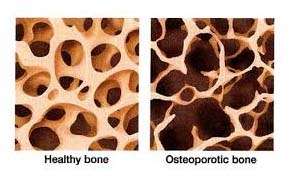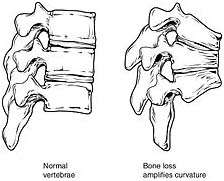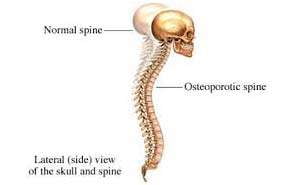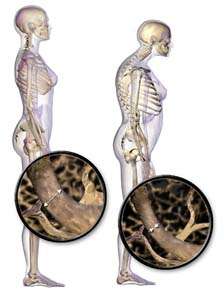The increased risk of falling associated with aging leads to fractures of the wrist, spine, and hip. The risk of falling, in turn, is increased by impaired eyesight due to any cause (e.g. glaucoma, macular degeneration), balance disorder, movement disorders (e.g. Parkinson’s disease), dementia, and sarcopenia (age-related loss of skeltel muscle).Collapse (transient loss of postural tone with or without loss of consciousness) leads to a significant risk of falls; causes of syncope are manifold but may include cardiac arrythmias (irregular heart beat),vasovagal syncope,orthostatic hypotension (abnormal drop in blood pressure on standing up), and seizures. Removal of obstacles and loose carpets in the living environment may substantially reduce falls. Those with previous falls, as well as those with gait or balance disorders, are most at risk.
Read More..
Risk factors of Osteoporosis
Risk factors for osteoporotic fracture can be split between non-modifiable and (potentially) modifiable. In addition, osteoporosis is a recognized complication of specific diseases and disorders. Medication use is theoretically modifiable, although in many cases, the use of medication that increases osteoporosis risk may be unavoidable. It is more likely in females than males.
Non-modifiable
Bone density peaks at about 30 years of age. Women lose bone mass more rapidly than men
• The most important risk factors for osteoporosis are advanced age (in both men and women) and female sex; estrogen deficiency following menopause or surgical removal of the ovaries is correlated with a rapid reduction in bone mineral density, while in men, a decrease in testosterone levels has a comparable (but less pronounced) effect.
• Race: While osteoporosis occurs in people from all ethnic groups, Europeon or Asian ancestry predisposes for osteoporosis.
• Heredity: Those with a family history of fracture or osteoporosis are at an increased risk; the heritability of the fracture, as well as low bone mineral density, is relatively high, ranging from 25 to 80%. At least 30 genes are associated with the development of osteoporosis.
• Those who have already had a fracture are at least twice as likely to have another fracture compared to someone of the same age and sex. Early menopause/hysterectomy is another predisposing factor.
• Build: A small stature is also a non-modifiable risk factor associated with the development of osteoporosis.
Potentially modifiable
• Excess consumption of alcohol: Although small amounts of alcohol are probably beneficial (bone density increases with increasing alcohol intake), chronic heavy drinking (alcohol intake greater than three units/day) probably increases fracture risk despite any beneficial effects on bone density.
• Vitamin D deficiency: Low circulating Vitamin D is common among the elderly worldwide.Mild vitamin D insufficiency is associated with increased parathyroid hormone (PTH) production. PTH increases bone resorption, leading to bone loss.
• Tobacco smoking: Many studies have been associated with smoking with decreased bone health, but the mechanisms are unclear. Tobacco smoking has been proposed to inhibit the activity of osteoblasts and is an independent risk factor for osteoporosis. Smoking also results in increased breakdown of exogenous estrogen, lower body weight, and earlier menopause, all of which contribute to lower bone mineral density.
• Malnutrition: Nutrition has an important and complex role in the maintenance of good bone. Identified risk factors include low dietary calcium and/or phosphorus, magnesium, zinc, boron, iron, fluoride, copper, vitamins A, K, E and C (and D where skin exposure to sunlight provides an inadequate supply). Excess sodium is a risk factor. High blood acidity may be diet-related and is a known antagonist of bone. Some have identified low protein intake as associated with lower peak bone mass during adolescence and lower bone mineral density in elderly populations. Conversely, some have identified low protein intake as a positive factor, protein is among the causes of dietary acidity. Imbalance of omega-6 to omega-3 polyunsaturated fats is yet another identified risk factor.
• High dietary protein from animal sources: Research has found an association between diets high in animal protein and increased urinary calcium, and have been linked to an increase in fractures. However, the relevance of this observation to bone density is unclear], since higher protein diets tend to increase absorption of calcium from the diet and are associated with higher bone density. Indeed, it has recently been argued that low protein diets cause poor bone health.
• Underweight/inactive: Bone remodeling occurs in response to physical stress, so physical inactivity can lead to a significant bone loss. Weight bearing exercise can increase peak bone mass achieved in adolescence, and a highly significant correlation between bone strength and muscle strength has been determined. The incidence of osteoporosis is lower in overweight people.
• Endurance training: In female endurance athletes, large volumes of training can lead to decreased bone density and an increased risk of osteoporosis. This effect might be caused by intense training suppressing menstruation, producing amenorrhoea, and it is part of the female athlete triad. However, for male athletes, the situation is less clear, and although some studies have reported low bone density in elite male endurance athletes, others have instead seen increased leg bone density.
• Heavy Metals: A strong association between cadmium and lead with the bone disease has been established. Low-level exposure to cadmium is associated with an increased loss of bone mineral density readily in both genders, leading to pain and increased risk of fractures, especially in the elderly and in females. Higher cadmium exposure results in osteomalacia (softening of the bone).
• Soft drinks: Some studies indicate soft drinks (many of which contain phosphoric acid) may increase the risk of osteoporosis, at least in women. Others suggest soft drinks may displace calcium-containing drinks from the diet rather than directly causing osteoporosis.
• Proton pump inhibitors (such aslansoprazole, esomeprazole, or omeprazole) that decrease stomach acid, are a risk for bone fractures if taken for two or more years, due to decreased absorption of calcium in the stomach
Medical disorders are associated with Osteoporosis
The body regulates calcium homeostasis with two pathways; one is signaled to turn on when blood calcium levels drop below normal and other one is the pathway that is signaled to turn on when blood calcium levels are elevated.
Many diseases and disorders have been associated with osteoporosis For some, the underlying mechanism influencing the bone metabolism is straightforward, whereas for others the causes are multiple or unknown.
• In general, immobilization causes bone loss (following the ‘use it or lose it’ rule). For example, localized osteoporosis can occur after prolonged immobilization of a fractured limb in a cast. This is also more common in active people with a high bone turnover (for example, athletes). Other examples include bone loss during space flight or in people who are bedridden or use wheelchairs for various reasons.
• Hypogonadal states can cause secondary osteoporosis. These include Turner syndrome,Klinefilter syndrome, Kallmann syndrome, anorexia nervosa, andropause,
hypothalamic amenorrhea or hyperprolactinemia. In females, the effect of hypogonadism is mediated by estrogen deficiency. It can appear as early menopause (<45 years) or from prolonged premenopausal amenorrhea (>1 year). Bilateral oophorectomy (surgical removal of the ovaries) and premature ovarian failure cause deficient estrogen production. In males, testosterone deficiency is the cause (for example, andropause or after surgical removal of the testes).
• Endocrine disorders that can induce bone loss include Cushing’s syndrome, hyperparathyroidism, hyperthyroidism, hypothyroidism, diabetes mellitus type 1 and 2, acromegaly and adrenal insufficiency. In pregnancy and lactation, the reversible bone loss may occur.
• Malnutrition, parentral nutrition, and malabsorption can lead to osteoporosis. Nutritional and gastrointestinal disorders that can predispose to osteoporosis include undiagnosed and untreated celiac disease (both symptomatic and asymptomatic people), Crohn’s disease, ulcerative colitis, cystic fibrosis, surgery (after gastrectomy, intestinal bypass surgery or bowl resection) and severe liver disease (especially primary biliary cirrhosis). People with lactose intolerance or milk allergy may develop osteoporosis due to restrictions of calcium-containing foods. Individuals with bulimia can also develop osteoporosis. Those with an otherwise adequate calcium intake can develop osteoporosis due to the inability to absorb calcium and/or vitamin D. Other micronutrients such as vitamin K or vitamin B12 deficiency may also contribute.
• People with rheumatologic disorders such as rheumatoid arthritis, ankylosing spondilytis, systemic lupus erythematosus and polyarticular juvenile idiopathic arthritis are at increased risk of osteoporosis, either as part of their disease or because of other risk factors (notably corticosteroid therapy). Systemic diseases such as amyloidosis and sarcoidosis can also lead to osteoporosis.
• Renal insufficiency can lead to renal osteodystrophy.
• Hematologic disorders linked to osteoporosis are multiple myeloma and other monoclonal gammopathies, lymphoma and leukemia, mastocytosis, hemophilia, sickle – cell disease and thalassemia.
• Several inherited disorders have been linked to osteoporosis. These include osteogenesis imperfecta, Marfan syndrome, hemochromatosis, hypophosphatasia (for which it is often misdiagnosed), glycogen storage diseases, homocystinuria Ehlers-Danlos syndrome, porphyria, Menkes’ syndrome, epidermolysis bullosa and Gaucher’s disease.
• People with scoliosis of unknown cause also have a higher risk of osteoporosis. Bone loss can be a feature of complex regional pain syndrome. It is also more frequent in people with Parkinson’s disease and chronic obstructive pulmonary disease.
• People with Parkinson’s disease have a higher risk of broken bones. This is related to poor balance and poor bone density. In Parkinson’s disease, there may be a link between the loss of dopaminergic neurons and altered calcium metabolism (and iron metabolism) causing a stiffening of the skeleton and kyphosis.
medications are associated with Osteoporosis
Certain medications have been associated with an increase in osteoporosis risk; only steroids and anticonvulsants are classically associated, but evidence is emerging with regard to other drugs
• Steroid –induced Osteoporosis (SIOP) arises due to use of glucocorticoids – analogous to Cushing’s syndrome and involving mainly the axial skeleton. The synthetic glucocorticoid prescription drug prednisone is the main candidate after prolonged intake. Some professional guidelines recommend prophylaxis in patients who take the equivalent of more than 30 mg hydrocortisone (7.5 mg of prednisolone), especially when this is in excess of three months. Alternate day use may not prevent this complication.
• Barbiturates, phenytoin and some other enzyme-inducing antiepileptics – these probably accelerate the metabolism of vitamin D.
• L-Thyroxine over-replacement may contribute to osteoporosis, in a similar fashion as thyrotoxicosis does. This can be relevant in subclinical hypothyroidism.
• Several drugs induce hypogonadism, for example, aromatase inhibitors used in breast cancer,methotexate and other antimetabolite drugs, depot progestrone and gonadotrophin-releasing hormone agonists.
• Anticoagulants – long-term use of heparin is associated with a decrease in bone density, and warfarin (and related coumarins) have been linked with an increased risk of osteoporotic fracture in long-term use.
• Proton pump inhibitors – these drugs inhibit the production of stomach acid; this is thought to interfere with calcium absorption. Chronic phosphate binding may also occur with aluminium-containing antacids.
• Thiazolidinediones (used for diabetes) –rosiglitazone and possiblypioglitazone, inhibitors of PPRAy, have been linked with an increased risk of osteoporosis and fracture.
• Chronic lithium therapy has been associated with osteoporosis.
Treatment of best Osteoporosis
Notwithstanding any causes described above following medications are therapeutically effective for Osteoporosis.
Corell capsule: 1 to 2 capsules three times a day
Chandra Prabha Vati (500mg): 1 tablet three times a day
Ashwagandha choorna : : 1teaspoonful three times a day
All the three with milk or water for 60 to 90 days



